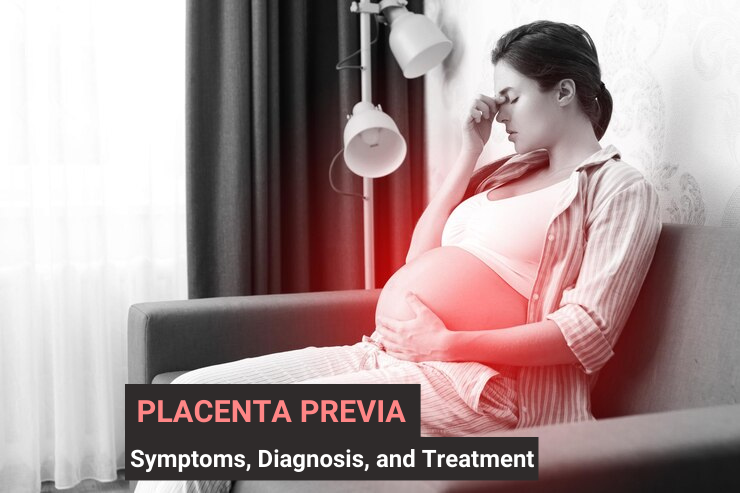Pregnant mothers with Placenta Previa suffer through intense physical and emotional turmoil. Managing pregnancy along with this condition is a challenging task for any woman to go through.
It is a serious medical condition during pregnancy where the Placenta creates a barrier preventing the baby’s exit from the vagina (cervix).
For instance, if the mother experiences heavy bleeding, the baby must be delivered by C-section as the placenta is blocking the baby’s passage through the birth canal. If you’ve had placenta previa in a past pregnancy, you have a 2 to 3 percent chance of having it again.
The prominent symptom is heavy bleeding during the second half of pregnancy, and pregnant women need to be aware of the signs and get proper medical care. However, not all women who experience heavy bleeding during pregnancy will miscarry.
You can manage your pregnancy with Placenta Previa successfully if you understand the condition in depth.
What is Placenta Previa?
Placenta Previa is a pregnancy complication where the placenta partially or completely covers the cervix, which allows your baby to be born. The situation can also cause vaginal bleeding during the second and third trimesters (after 20 weeks) of pregnancy, which can be a sign of the condition.
During pregnancy, the placenta develops inside the uterus. It acts as a barrier between the mother and baby, allowing the exchange of oxygen and nutrients while blocking out harmful organisms and toxins.
Placenta Previa can happen during a vaginal delivery when your baby passes through the cervix and the birth canal. The placenta generally does not connect close to the cervix. It happens in 1 out of 200 pregnancies.
Placenta previa causes:
- As your cervix expands during pregnancy, the blood vessels that directly connect the placenta to the uterus might tear up.
- This could result in bleeding, endangering both the mother and her unborn child.
- The only way to prevent this from happening for women with this condition is to have a C-section.
Classifications of Placenta Previa?
Placenta Previa can be classified into three types as follows:
- Total: The placenta covers the entire vaginal opening
- Marginal: Placenta is next to the cervix, but does not close the opening.
- Partial: Placenta covers part of the cervix.
Vaginal bleeding in pregnancy or labor can happen from any type of placenta previa.
Bleeding during the early phases of pregnancy doesn’t pose major problems since it resolves and improves with time. It is still recommended that you consult a medical professional as soon as possible.
What causes Placenta Previa?
The condition can be found in women who have:
- Multiple pregnancies (twins or triplets).
- An abnormally shaped uterus.
- Had various pregnancies in the past.
- History of surgery, a C-section, or an abortion that left scarring on the uterine lining.
- Artificial Insemination
- Age 35 or older.
- Smoke and do drugs.
Detailed about: Placenta Prevai Causes & Risk Factors
Women who smoke, use drugs, or have children at an older age may be at a higher risk as well.
Signs and Symptoms?
- You may experience light to heavy painless bleeding from your vagina during the second half of your pregnancy.
- Cramps pain along with bleeding. You will feel pain in your back or cramping from contractions.

Diagnosis:
With ultrasound, you can diagnose the condition of Placenta Previa. You can do it during your regular prenatal appointments, as well as when bleeding occurs. The majority of cases of placenta previa are identified during second-trimester ultrasounds.
Treatment:
- Early-stage Placenta Previa resolves on its own

- The situation automatically gets better when the uterus grows. As the uterus grows, the distance between the cervix and the placenta also increases. In addition, the direction of placental growth in the uterus may be higher, and the edges of placental tissue close to the cervix may shrink.
- You might be able to prepare for a vaginal delivery if the placenta previa resolves. If it does not resolve, you will have to prepare yourself for a C-section delivery.
This is similar to taking two paths to the same destination – one is a winding, uphill road and the other is a straight line. You may be able to take the winding road, but if it’s blocked, you’ll have to take the straight line.
- Treatment for Bleeding
- Bleeding after 20 weeks of pregnancy is treated as a medical emergency.
- To repair the blood loss, both mother and child will be monitored and will need blood transfusions.
- At 36 weeks vaginal bleeding, you will deliver your baby via C-section. In case of heavy bleeding, an emergency C-section delivery will be needed to safeguard the health of the mother and her unborn child.
- If this was your first episode and the bleeding has stopped for at least 48 hours, then you will be sent home. If heavy bleeding continues, you will remain under medical supervision for as long as your healthcare team requires.
- Treatment with no Bleeding
When there is no bleeding, the purpose of treatment is to lower the risk of future bleeding and to bring you as close to the due date as possible.
Your doctor will probably advise you to avoid the following:
- Sexual intercourse that could lead to orgasm
- Intensive or moderate workout
- Hefty lifting or exercising
- Standing or walking for a long time
All of these activities can lead to muscular fatigue and soreness.
Conclusion
Placenta Previa can be dangerous as well as challenging for pregnant mothers and their baby, but regular check-ups and maintaining a healthy lifestyle from the beginning will prevent you from falling into such severe medical conditions.
This is like a marathon for your body, where you need to keep pushing and challenging yourself to reach the finish line.
Placenta Previa is a complicated condition of pregnancy where the placenta creates a barrier preventing your baby’s exit from your vagina. This condition can cause heavy bleeding and other complications, making it essential for pregnant women to be aware of the signs and get proper medical care. Early detection of the symptoms is essential to ensure a safe and healthy pregnancy, as well as the best possible outcome for both mother and baby.


